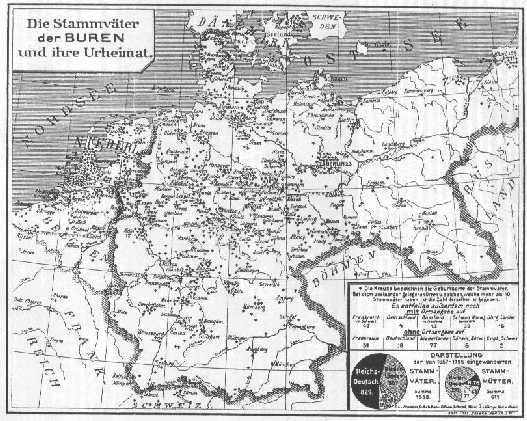
Click on the picture to enlarge
A watering station was established by the Dutch East India Company in Table Bay close to the Cape of Good Hope in 1652. Because of the suitable climate, Europeans settled in the area around Table Bay, which developed first into the Cape Colony and is therefore the precursor to what is now South Africa.
Up to 1806, when the Cape Colony passed into British possession, the Dutch were the biggest factor in the population and political equations and Dutch was the undisputed lingua franca of the colony. Apart from the Dutch, there were significant minorities of French Huguenots, Germans, Khoi natives (Hottentots) and Malay slaves. Most of the Europeans arrived as unmarried soldiers or employees of the Dutch East India company. At the Cape they would marry Dutch, Malay or Khoi wives and were absorbed into the main body of Dutch speakers. As a result, both German and French surnames are common among the Afrikaners, the modern-day descendants of the Dutch, but neither group established a separate identity at the Cape during the early years. Many Germans, especially those from Northern Germany, would have found Dutch very similar to their home language of Low German (Plattdeutsch), so there was little incentive to forming a separate subgroup within the population. Only towards the end of the 18th Century, a number of Germans tried to establish a Lutheran congregation at the Cape, but this effort was based more on religious considerations than linguistic ones.

All together, there were about 4000 Germans that emigrated to the Cape during the Dutch period - almost all of them males. They came from all German-speaking areas of Europe, as can be seen from the map above. A number of books have been written about the early German immigrants, most notably Hoge's "Personalia of the Germans at the Cape".
The following pages contain a summary of the data collected by Hoge. The amount of data Hoge included per person varies widely, depending on what sources it was taken from. I have tried to restrict the data in my lists to the four most important items, viz. surname, first name, place of origin and the first date available for the entry (birth date, date of arrival, date of marriage, date of death). Any other data included in the book is available from me on request (Here are some examples of some of the entries.)
To view the lists, please choose one of the links below. To search the lists, please use the general search function on the main page.